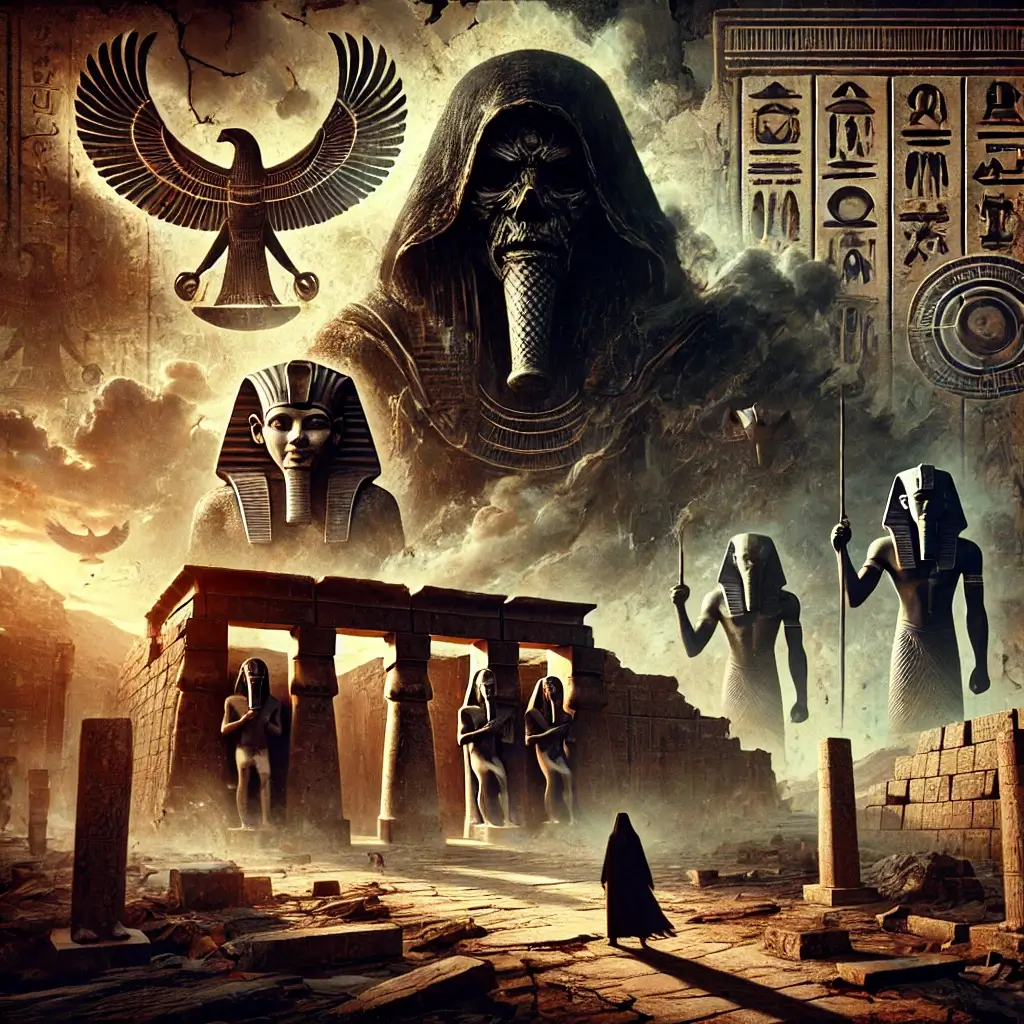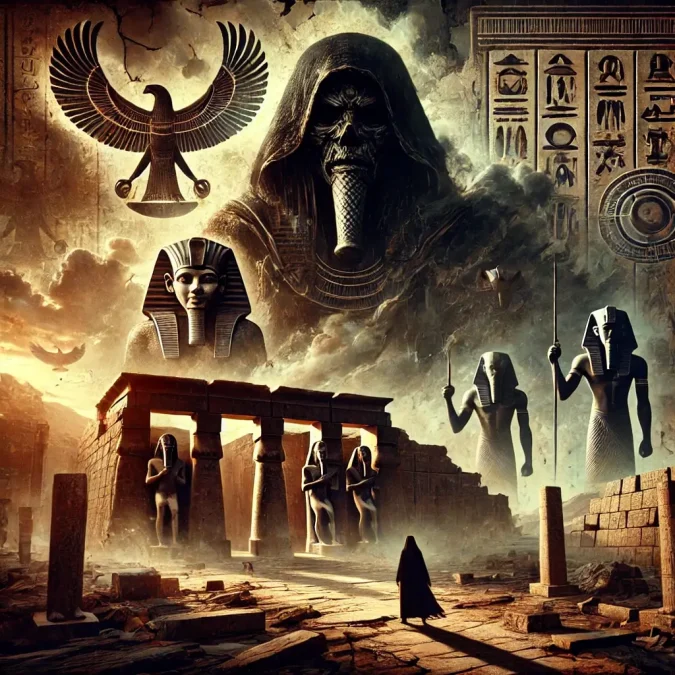
The Ninth Dynasty of ancient Egypt (c. 2160–2130 BC), also known as Dynasty IX, is one of the dynasties that formed part of the tumultuous First Intermediate Period. The First Intermediate Period, which includes the Seventh, Eighth, Ninth, Tenth, and early Eleventh Dynasties, was a time of political fragmentation, economic decline, and social unrest following the collapse of the Old Kingdom. The Ninth Dynasty, in particular, was characterized by the rise of rulers from Herakleopolis, who sought to establish their dominance over a divided Egypt. The takeover by the rulers of Herakleopolis was often violent, and Manetho, the ancient historian, describes Achthoes, the founder of the dynasty, as “more terrible than his predecessors” and one who “wrought evil things for those in all Egypt.”
The Ninth Dynasty marks the beginning of a period of significant change in Egypt, as local leaders and regional rulers competed for power in the absence of a strong central authority. In this article, we will explore the history, rulers, cultural developments, and challenges faced by the Ninth Dynasty, along with the contributions of each pharaoh and their impact on ancient Egyptian civilization.
The Historical Context of the Ninth Dynasty
The First Intermediate Period: A Time of Fragmentation and Struggle
The First Intermediate Period of ancient Egypt was a time of political fragmentation and instability, following the decline of the Old Kingdom. The collapse of centralized governance at the end of the Sixth Dynasty led to the rise of regional power centers, with local leaders and nomarchs gaining increasing authority over their territories. This period of disunity is often described as a “dark age” in Egyptian history, characterized by a lack of strong central leadership, economic challenges, and social upheaval.
The Ninth Dynasty emerged in this context of political fragmentation, following the mysterious and short-lived Seventh and Eighth Dynasties. The rulers of the Ninth Dynasty were based in Herakleopolis, a city located in Middle Egypt. From their seat of power, they sought to extend their influence over the entire country, but their rule was marked by conflict and violence. The rise of the Ninth Dynasty was marked by attempts to consolidate power and bring stability to a divided Egypt, but their efforts were often met with resistance from rival factions and local leaders.
The Rise of Herakleopolis
Herakleopolis, known as Henen-Nesut in ancient Egyptian, became the seat of power for the rulers of the Ninth Dynasty. Located strategically between Upper and Lower Egypt, Herakleopolis played a crucial role in the political landscape of the First Intermediate Period. The rulers of Herakleopolis sought to establish their dominance over Egypt, but their authority was challenged by rival power centers, particularly those in Thebes, which would later become the center of the Eleventh Dynasty.
The founder of the Ninth Dynasty, Achthoes (also known as Khety I), is described by Manetho as a cruel and tyrannical ruler. The violent nature of the takeover by the Herakleopolitan rulers is reflected in Manetho’s description of Achthoes as “more terrible than his predecessors” and one who “wrought evil things for those in all Egypt.” Despite their efforts to assert control, the rulers of the Ninth Dynasty faced significant challenges in maintaining their authority over a fragmented and divided Egypt.
The Rulers of the Ninth Dynasty
The Ninth Dynasty of Egypt is known for its rulers, who played a crucial role in shaping the history of the First Intermediate Period. The following section provides a summary of the key rulers of the Ninth Dynasty and their contributions to Egyptian history.
King Khety I (Achthoes)
Khety I, also known as Achthoes, is traditionally considered the founder of the Ninth Dynasty. According to Manetho, Khety I was a cruel and tyrannical ruler who brought suffering to the people of Egypt. His rise to power was marked by violence, as he sought to establish his authority over a divided and unstable country. Khety I ruled from Herakleopolis, and his primary goal was to consolidate power and bring stability to the region.
Despite his reputation for cruelty, Khety I was able to establish the Ninth Dynasty and lay the foundation for the rule of his successors. His reign was marked by attempts to reassert central authority, but he faced significant resistance from regional leaders and rival factions. The lack of strong central control and the ongoing challenges to his authority made it difficult for Khety I to achieve lasting stability.
King Khety II
Khety II, the successor of Khety I, continued the efforts to consolidate power and extend the influence of the Herakleopolitan rulers. His reign is poorly documented, and there is little information available about his achievements. It is likely that Khety II faced ongoing challenges to his authority, as regional leaders continued to assert their independence and resist central control. The political instability of the First Intermediate Period made it difficult for the pharaohs of the Ninth Dynasty to maintain control over the entire country.
Khety II’s reign was marked by attempts to strengthen the central government and bring stability to Egypt, but his efforts were often met with resistance from rival power centers. The lack of significant achievements or monumental construction projects suggests that his authority was limited, and he may have struggled to maintain control over a divided Egypt.
King Nebkaure Khety
Nebkaure Khety was another ruler of the Ninth Dynasty, whose name is known from a few inscriptions and historical records. His reign, like those of his predecessors, was marked by ongoing struggles to maintain control over Egypt. The political fragmentation of the country made it difficult for Nebkaure Khety to assert his authority, and he faced challenges from regional leaders who sought to establish their own power bases.
Nebkaure Khety’s reign is notable for the continuation of the struggles between the Herakleopolitan rulers and the regional power centers in Upper Egypt, particularly in Thebes. The rise of Theban rulers, who would later form the Eleventh Dynasty, posed a significant threat to the authority of the Ninth Dynasty, and the rivalry between Herakleopolis and Thebes would continue to shape the political landscape of the First Intermediate Period.
King Merikare
Merikare is one of the most well-known rulers of the Ninth Dynasty, although he is sometimes considered part of the Tenth Dynasty. His reign is notable for the “Teaching for King Merikare,” a text that provides insight into the challenges faced by the rulers of the First Intermediate Period and the strategies they used to maintain control. The text, which is presented as advice from a father to his son, emphasizes the importance of justice, good governance, and the need to maintain harmony in the face of political instability.
Merikare’s reign was marked by attempts to bring stability to Egypt and strengthen the central government. He sought to build alliances with regional leaders and promote economic prosperity, but his efforts were often undermined by ongoing conflicts and rivalries. The “Teaching for King Merikare” reflects the difficulties faced by the rulers of the Ninth Dynasty and their desire to restore order and stability to a fragmented Egypt.
Cultural and Political Factors During the Ninth Dynasty
The Weakening of Central Authority
One of the defining characteristics of the Ninth Dynasty was the weakening of central authority. The decline of the Old Kingdom and the rise of regional power centers meant that the pharaohs of the Ninth Dynasty had limited control over Egypt. The increasing power of regional officials, known as nomarchs, led to the fragmentation of the country, as these officials asserted their independence and established their own power bases. The pharaohs of the Ninth Dynasty were unable to effectively challenge the authority of these regional leaders, leading to a decline in the power of the central government.
The Rise of Thebes and Rival Power Centers
The rise of Thebes as a rival power center was a significant factor in the decline of the Ninth Dynasty. The Theban rulers, who would later form the Eleventh Dynasty, sought to establish their own authority in Upper Egypt and challenge the rule of the Herakleopolitan kings. The rivalry between Herakleopolis and Thebes was a defining feature of the First Intermediate Period, as both regions competed for control over Egypt. The eventual victory of the Theban rulers would lead to the reunification of the country and the establishment of the Middle Kingdom.
Economic Challenges and Social Unrest
The economic challenges faced by Egypt during the Ninth Dynasty also contributed to the decline of the central authority. The collapse of the centralized economy of the Old Kingdom, combined with the unpredictability of the Nile’s flooding, led to reduced agricultural yields and food shortages. These economic challenges created social unrest, as the central government struggled to provide for the population and maintain stability. The lack of resources and the inability to collect taxes further weakened the power of the pharaohs and contributed to the decline of the Ninth Dynasty.
The Role of Literature and Wisdom Texts
Despite the challenges of the Ninth Dynasty, this period also saw the development of important literary works, including wisdom texts that provided guidance on governance and morality. The “Teaching for King Merikare” is one such text, offering advice on how to be a just and effective ruler. These texts reflect the concerns of the time, as the rulers of the Ninth Dynasty sought to restore order and stability to a divided Egypt. The emphasis on justice, good governance, and the importance of maintaining harmony highlights the desire of the Herakleopolitan rulers to reestablish central authority and bring an end to the chaos of the First Intermediate Period.
The Onset of the Middle Kingdom
The Ninth Dynasty marks an important transition in Egyptian history, as it set the stage for the reunification of the country and the rise of the Middle Kingdom. The struggles between Herakleopolis and Thebes eventually led to the victory of the Theban rulers, who succeeded in reuniting Egypt under the rule of the Eleventh Dynasty. The reunification of Egypt brought an end to the First Intermediate Period and marked the beginning of the Middle Kingdom, a time of renewed cultural and political prosperity.
The legacy of the Ninth Dynasty is evident in the cultural and social changes that took place during the First Intermediate Period, as regional leaders asserted their independence and established their own power bases. The challenges faced by the rulers of the Ninth Dynasty highlight the difficulties of maintaining central authority in a time of political fragmentation and economic decline. Despite these challenges, the Ninth Dynasty played a crucial role in shaping the history of Egypt and setting the stage for the reunification of the country.
Conclusion
The Ninth Dynasty of ancient Egypt was a short-lived and turbulent period, marking a time of political fragmentation and instability during the First Intermediate Period. The pharaohs of the Ninth Dynasty, from Khety I to Merikare, faced significant challenges in maintaining control over a divided Egypt, as regional power centers emerged and the authority of the central government declined. The rise of Thebes as a rival power center and the ongoing conflicts between Herakleopolis and Thebes defined the political landscape of the First Intermediate Period and ultimately led to the reunification of Egypt under the Eleventh Dynasty.
Despite the challenges of this period, the Ninth Dynasty is an important part of Egypt’s history, as it helps us understand the complexities and struggles that eventually led to the reunification of the country during the Middle Kingdom. The legacy of the Ninth Dynasty is evident in the enduring cultural and social changes that took place during the First Intermediate Period, as regional leaders asserted their independence and established their own power bases.
